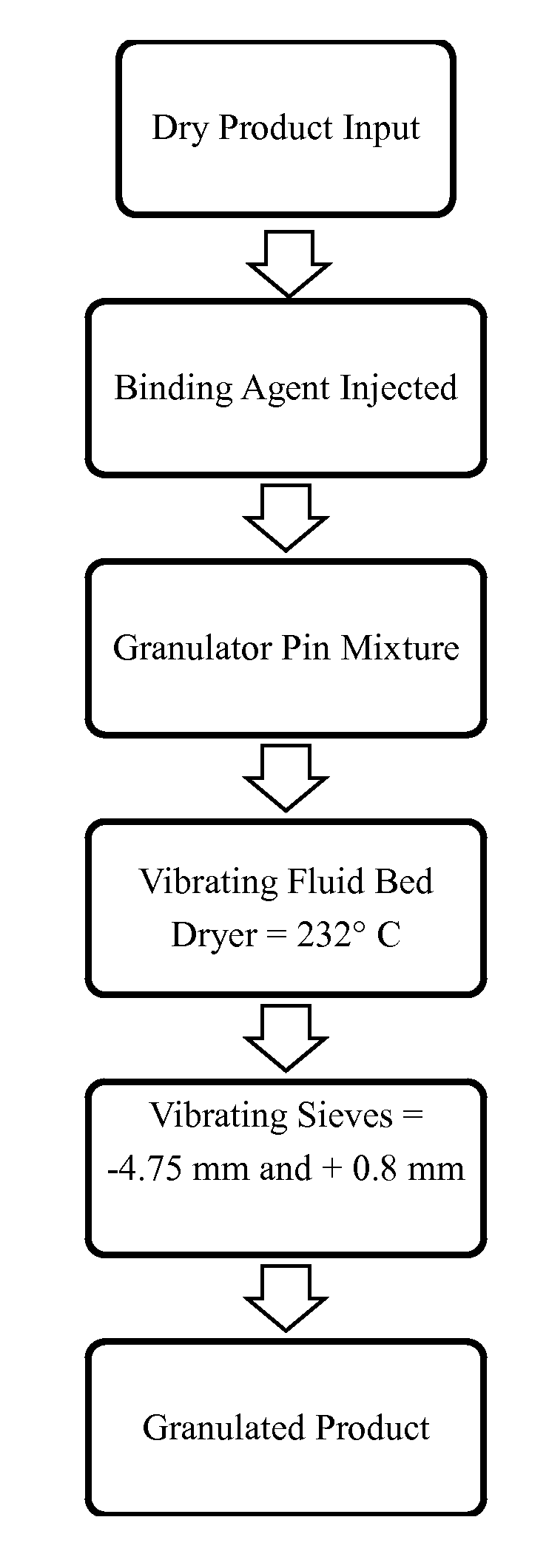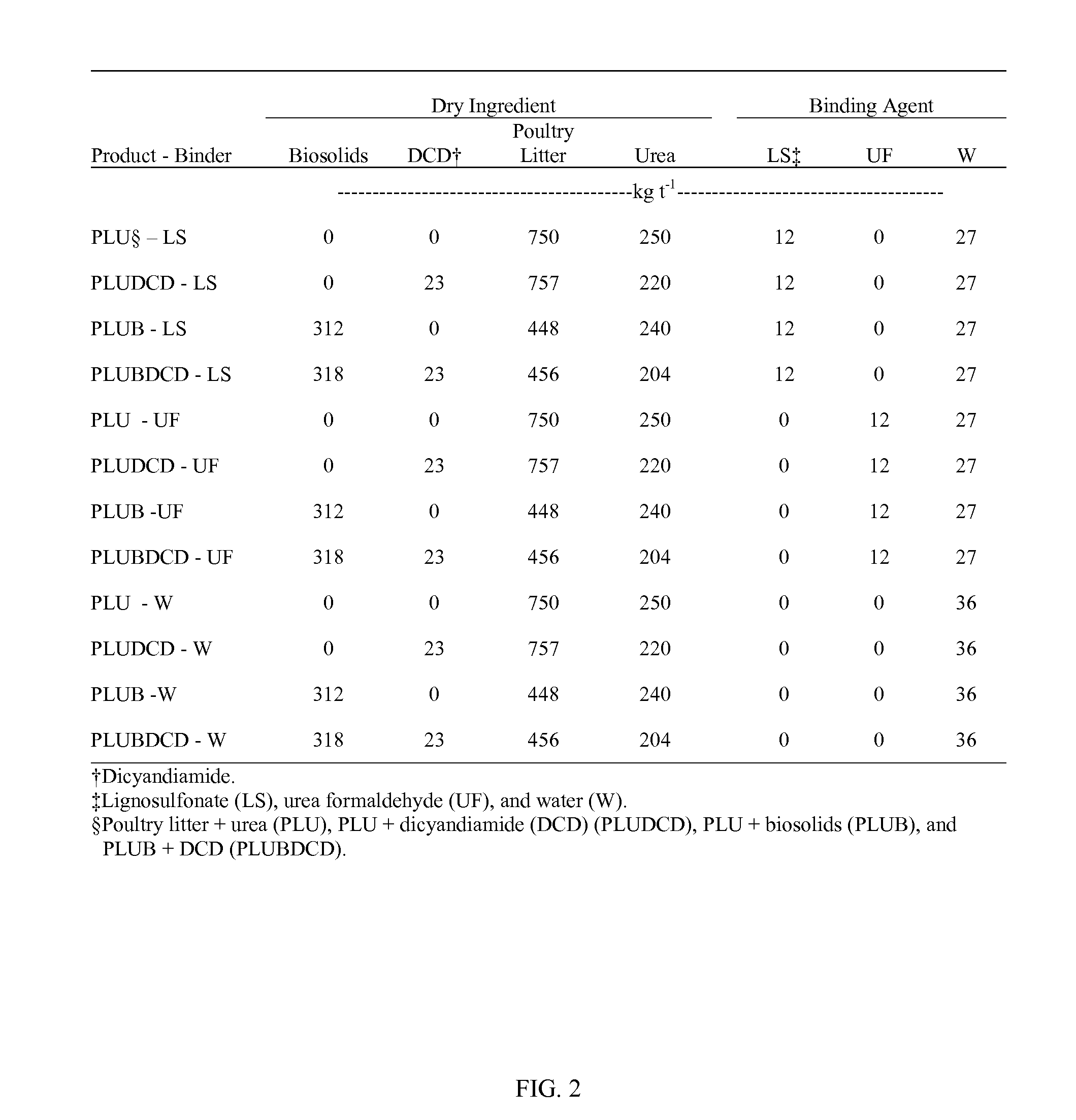Value-added granulated organic fertilizer and process for producing the same
- Summary
- Abstract
- Description
- Claims
- Application Information
AI Technical Summary
Benefits of technology
Problems solved by technology
Method used
Image
Examples
example 1
Materials and Methods
[0069]Research plots were established in 2004-2006 at the Rice Research and Extension Center near Stuttgart, Ariz. (34° 27′N; 91° 33′W) to test flood-irrigated rice response to N fertilizers developed from PL. Plots were situated on a Dewitt silt loam (fine, smectitic, thermic Typic Albaqualfs) previously cropped with soybean (Glycine max (L.) Merr). Fertilizer treatments were fresh PL, PLU, PLUDCD, and urea. Fresh PL, PLU and PLUDCD treatments were applied to dry soil and incorporated using a rotary tiller (FIG. 14). “Wells” rice was immediately planted after fertilizer incorporation at 100 lb seed / acre. In 2004, preflood urea treatments were applied to wet soil at the 5-leaf growth stage and a permanent 10-cm flood was established within 3 days (FIG. 14). In 2005 and 2006, preflood urea treatments were applied to dry soil and permanent flood was established within 24 hours (FIG. 14). All N sources were applied on a TN basis at 60, 100, 140, and 180 lb N / acre, ...
example 2
Materials and Methods
[0078]Research plots were established in 2004-2005 at the Lon Mann Cotton Research Station in Marianna, Ariz. (34° 46′N; 90° 45′W) to test upland seed cotton yield to N fertilizers developed from PL (FIG. 19). Plots were located on a Loring silt loam (Fine-silty, mixed, active, thermic Oxyaquic Fragiudalfs) cropped in sod prior to 2004 and cotton prior to 2005. Fertilizer treatments were fresh PL, PLU, PLUDCD, urea applied at-planting, and urea 50-50 split applied between at-planting and first match head square formation (FIG. 20). Fresh PL, PLU and PLUDCD treatments were applied to dry soil and incorporated. ‘Stoneville 4892BR’ cotton was immediately planted after fertilizer incorporation at 89,000 plants had. All N sources were applied on a TN basis at 34, 67, 101, 134, and 168 kg N ha−1, and a 0-N control was also included. Seed cotton yield was determined by harvesting the middle two (2) rows from each four (4) row plot.
[0079]The experiment was arranged in a...
example 3
Materials and Methods
[0082]Research was conducted on a Captina silt loam (Fine-silty, siliceous, active, mesic Typic Fragiudult), had 4% slope, and was seeded with bermudagrass (Cynodon dactylon) manicured as a golf course fairway. Background soil characteristics taken before rainfall simulations are listed in FIG. 22. Soil concentrations were multiplied by 1,831,100 lbs soil / acre furrow slice (four (4) inch depth) to achieve nutrient concentrations per acre. For fertilizer and soil, inorganic N and DRP were extracted on a 1:10 ratio of 2 M KCl and deionized water, respectively. TN was found by dry combustion and organic N determined by subtracting inorganic N from TN. Total P was quantified by a concentrated HNO3 and H2O2 digest. Nitrogen-fortified PL and BS granular fertilizers, BS, Milorganite, fresh PL, and urea+TSP treatments were applied on a TP basis at a rate of 18 lbs P / acre. The rates of inorganic N, organic N, TN, DRP, and total solids applied are presented in FIG. 22. Al...
PUM
 Login to View More
Login to View More Abstract
Description
Claims
Application Information
 Login to View More
Login to View More - R&D
- Intellectual Property
- Life Sciences
- Materials
- Tech Scout
- Unparalleled Data Quality
- Higher Quality Content
- 60% Fewer Hallucinations
Browse by: Latest US Patents, China's latest patents, Technical Efficacy Thesaurus, Application Domain, Technology Topic, Popular Technical Reports.
© 2025 PatSnap. All rights reserved.Legal|Privacy policy|Modern Slavery Act Transparency Statement|Sitemap|About US| Contact US: help@patsnap.com



